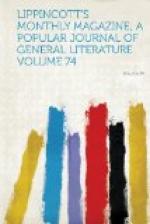If only one could eat flowers, or if wheat and other cereals grew as freely and luxuriously as flowers grow, how nice it would be! On the open grassy downs about here the blossoms are lovely—beautiful lilies in scarlet and white clusters, several sorts of periwinkles, heaths, cinnerarias, both purple and white, and golden bushes of citisus or Cape broom, load the air with fragrance. By the side of every “spruit” or brook one sees clumps of tall arum lilies filling every little water-washed hollow in the brook, and the ferns which make each ditch and water-course green and plumy have a separate shady beauty of their own. This is all in Nature’s own free, open garden, and when the least cultivation or care is added to her bounteous luxuriance a magnificent garden for fruit, vegetables and flowers is the result; always supposing you are fortunate enough to be able to induce these lazy Kafirs to dig the ground for you.
About a fortnight ago I braved the dirt and disagreeables of a cross-country walk in showery weather—for we have not been able to meet with a horse to suit us yet—and went to see a beautiful garden a couple of miles away. It was approached by a long double avenue of blue gum trees, planted only nine years ago, but tall and stately as though a century had passed over their lofty, pointed heads, and with a broad red clay road running between the parallel lines of trees. The ordinary practice of clearing away the grass as much as possible round a house strikes an English eye as bare and odd, but when one hears that it is done to avoid snakes, it becomes a necessary and harmonious adjunct to the rest of the scene. In this instance I found these broad smooth walks, with their deep rich red color, a very beautiful contrast to the glow of brilliant blossoms in the enormous flower-beds. For this garden was not at all like an ordinary garden, still less like a prim English parterre. The beds were as large as small fields, slightly raised and bordered by a thick line of violets. Large shrubs of beautiful semitropical plants made tangled heaps of purple, scarlet and white blossoms on every side; the large creamy bells of the datura drooped toward the reddish earth; thorny shrubs of that odd bluish-green peculiar to Australian foliage grew side by side with the sombre-leaved myrtle. Every plant grew in the most liberal fashion; green things which we are accustomed to see in England in small pots shoot up here to the height of laurel bushes; a screen of scarlet euphorbia made a brilliant line against a background formed by a hedge of shell-like cluster-roses, and each pillar of the verandah of the little house had its own magnificent creeper. Up one standard an ipomea twined closely; another pillar was hidden by the luxuriance of a trumpet-honeysuckle; whilst a third was thickly covered by an immense passion-flower. In shady, damp places grew many varieties of ferns and blue hydrangeas, whilst other beds were filled by gay patches of verbenas of every hue and shade.




